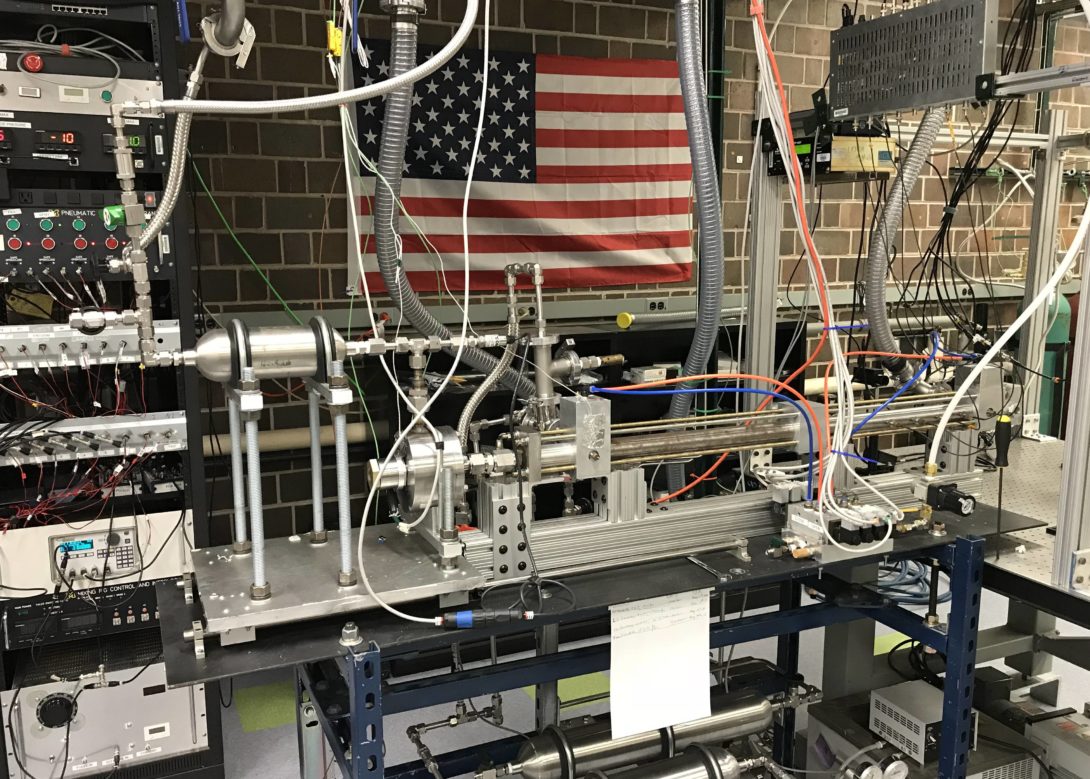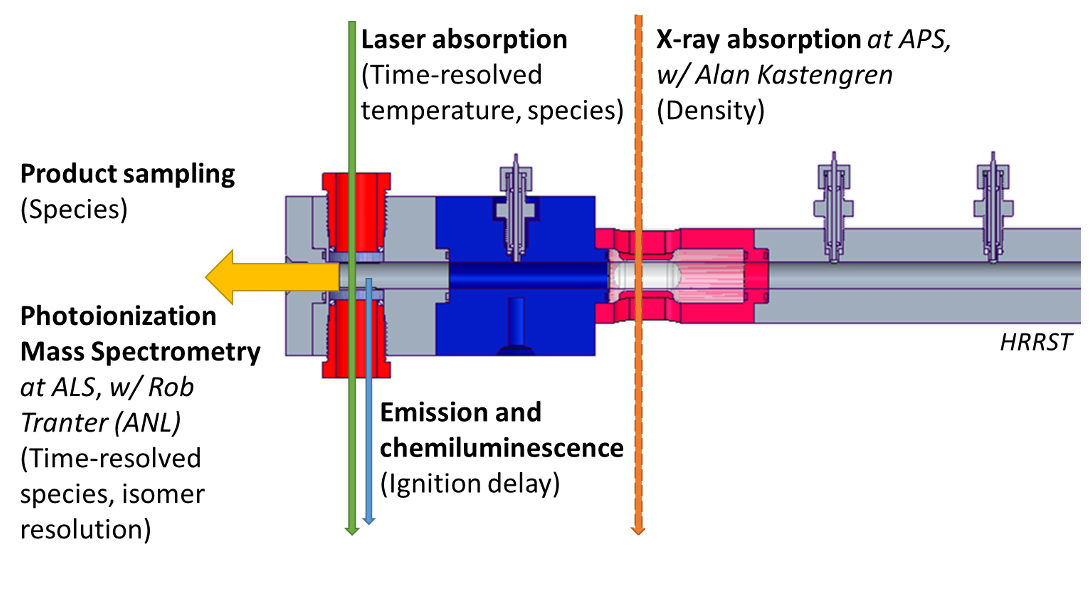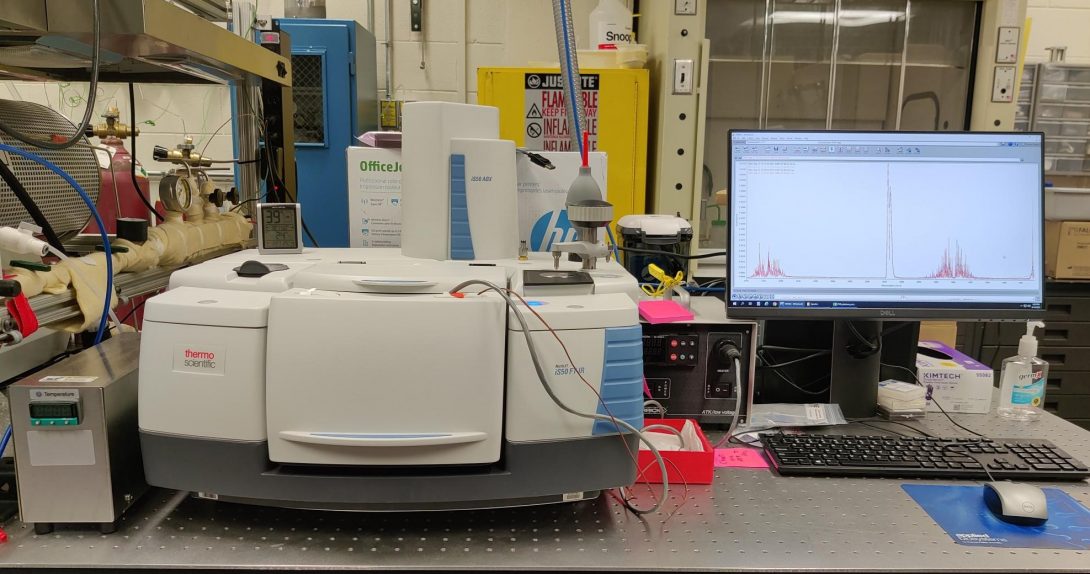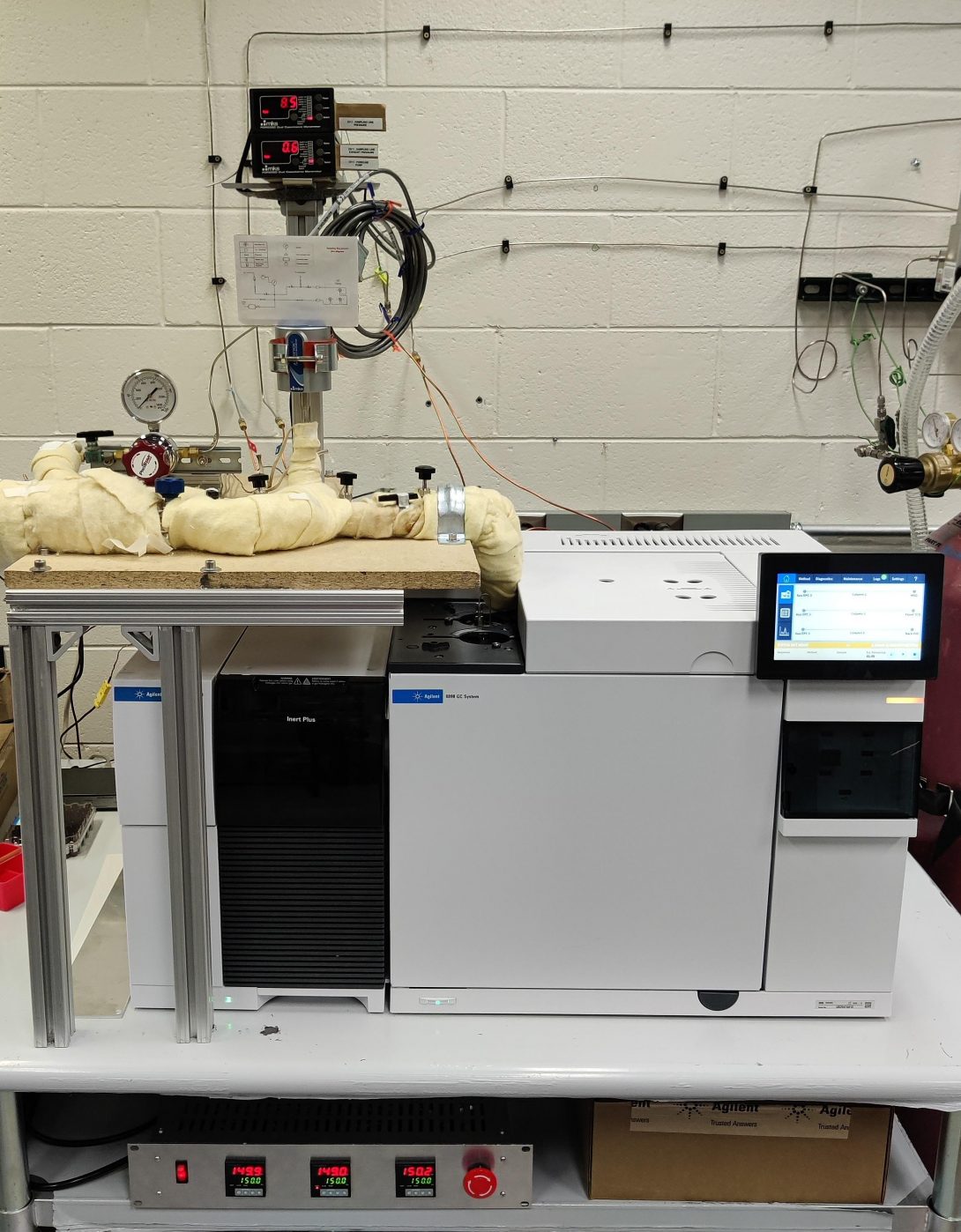Introduction
Welcome to the Lynch Laboratory Homepage.
The Problems
We are interested in a variety of combustion and kinetics problems with applications in propulsion.
We are currently focused on:
- The measurement of reaction rates and species information relevant to the ignition of various fuels
- The development of advanced tools to accurately make these measurements
- Ignition, especially in new aviation relevant fuels
- Sensing properties of fuels, especially ignition relevant properties.
For more information on our current projects, please consult the Research Page.
The Machines

Most of the experimental work in the laboratory involves using a 12.7 mm bore miniature high repetition rate shock tube (HRRST). In a shock tube, shock waves are used to generate high temperature, high pressure, controlled environment conditions. It is in those conditions that we study combustion phenomena. Miniature shock tubes use the opening of a fast acting solenoid valve separating the driver and driven section in order to generate the incident shock. The whole process is automated, (usually 1 experiment every 2-4 seconds) and includes filling the test gas, performing the experiment, and purging the residual gases in preparation for the next experiment.
The main advantages are in the ability to quickly sweep out a wide range of experimental conditions and to repeatedly access conditions. One approach to measure weak signals is to employ signal averaging (this is very hard for conventional shock tubes because of large differences shot-to-shot). This repeatability permits experiments otherwise impossible to perform. The disadvantages include a short test time, short path length for single pass diagnostics, and less than perfect gas conditions following the reflected shock. Some of these can be overcome with modelling.
For more information on the miniature shock tube, its operation, schematics, etc. consult:
- P.T. Lynch, “Note: An Improved Solenoid Driver Valve For Miniature Shock Tubes” Review of Scientific Instruments 87 2016 056110. doi:10.1063/1.4953115
- P. T. Lynch, G. Wang “Chemical Thermometry in Miniature HRRST using 1,1,1-Trifluoroethane Dissociation” Proceedings of the Combustion Institute 36 2017, 307-314. doi:10.1016/j.proci.2016.05.057
- R. S. Tranter, P. T. Lynch, “A Miniature High Repetition Rate Shock Tube,” Review of Scientific Instruments, 84(9) 2013, 094102. doi:10.1063/1.4820917
Other techniques currently being developed involve similar miniaturization and automation applied to other high pressure reactors, including rapid compression machines.
The Techniques (1)

The HRRST is used for a variety of experimental measurements including high temperature ignition delay, time-resolved species concentrations measured with tunable diode laser spectroscopy, and even high temperature fluid mechanic measurements using synchrotron sourced techniques.
There are a number of diagnostic tools available. These are a few that we are using.
Optical Diagnostic Equipment and Capabilities:
- Tunable diode lasers: 2x CO, CH2O, H2O, I, HF, and suitable detectors.
- 671B-MIR wavelength meter from Bristol: wavelength accuracy is ±1.0ppm (±0.006nm at 6250nm) with wavelength range 1.5µm to 12µm.
- OSA205c from Thorlabs: wavelength accuracy is ±1.0ppm with wavelength range 1.0µm to 5.6µm.
- Custom spectrometers with high speed line detectors and ccd cameras, and various light sources.
- High speed imaging: Photron FASTCAM Nova S9
The Techniques (2)

Recent work focuses on IR characterization of liquids and gases. We have a Nicolet is50 FTIR.
Diagnostic Capabilities:
- FTIR spectrometer covers NIR to Far IR spectral range(12000-400cm-1) at resolutions ranging from 0.125cm-1 to 32 cm-1.
- This instrument is used for analyzing liquid and gaseous samples of interest like fuels, chemical components and gas mixtures. ATR allows qualitative analysis of liquid and solids.
- FTIR is capable of measuring liquid samples in a temperature-controlled liquid cell at path lengths ranging from 6µm to 1000µm
- FTIR can be coupled with a temperature-controlled gas cell of 2m long path length for gas phase analysis
The Techniques (3)

Recent work also focuses on analysis of species analysis of liquids and gases. We have an Agilent 8890/5977 GC/MSD System
The 8890/5977 GC/MSD allows to analyze a sample to identify the compounds present in the sample. The sample is vaporized and exits the column at different times into the detectors. Our GCMS system uses three detectors for identifying the compounds.
Currently installed detectors and columns:
- FID – GasPro Column – capable of detecting compounds containing up to 6 carbon atoms.
- TCD – Molsiv Column – capable of detecting permanent gases like He, N2, O2, etc.
- MS – HP5 Column – capable of detecting compounds containing 6-14 carbon atoms.
We use a custom built sampling line maintained at a temperature of 150°C to inject gas or liquid samples into the columns. The sampling line allows for dilution of samples with Helium, if dilution is required, and the sampling lines are made of Sulfinert treated components to prevent reaction of samples with the components.
The Other Stuff
Despite the experimental focus, many of the problems we solve require extensive computational supporting efforts including: chemically reactive modeling, computational fluid mechanics, custom data acquisition, and large data handling and processing.